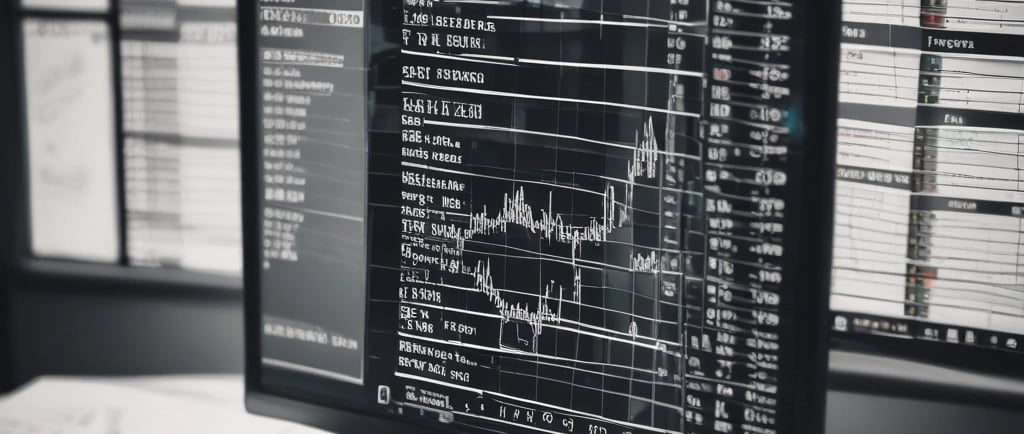Improve your trading with Order Flow
HIT TRADING LAB
4 min read


What is Order Flow ?
Order flow is a key concept in trading that focuses on the analysis of orders executed in the market. Unlike traditional analysis methods that rely on charts and technical indicators, order flow directly examines actual transactions, providing a more accurate perspective on market forces. By observing past buy and sell orders, traders can anticipate future market movements and gain a competitive advantage.
Order flow works by collecting and analyzing transaction data. For example, by monitoring order volume, the speed at which orders are executed, and the price levels at which they occur, traders can assess the strength of market participants.
One of the advantages of order flow, for example, is its ability to identify liquidity zones—price levels where a large number of orders have been placed. These areas can act as barriers where the market price could react significantly, thus offering attractive trading opportunities. Compared to traditional methods, Order Flow emphasizes the quantitative aspects of trading, allowing traders to make decisions based on real data and not subjective interpretations.
In this context, it becomes clear that Order Flow represents not just an analytical tool, but a distinct approach that values transparency and objectivity in trading decisions. Its ability to provide insights into the behavior of market participants in real time makes it indispensable for professional traders looking to optimize their investment strategies.
Why Order Flow is underrated ?
Order flow, despite its undeniable effectiveness in trading, is often underestimated by many amateur traders. There are several reasons for this neglect, including misperceptions and a lack of education. First, many novice traders believe that simple analytical methods, such as technical analysis or trend indicators, are sufficient to make informed decisions. While these approaches can deliver results, they cannot compete with the depth of analysis provided by order flow.
Second, unlike other popular techniques, few educational resources address this analytical tool. Novice traders often lack a clear understanding of how to read order flow, which limits their ability to integrate it into their strategies. As a result, they often avoid this powerful method, relying instead on techniques they consider more accessible.
Furthermore, the tendency to favor less complex methods is partly explained by the desire for quick results. In an industry where the pressure to perform is high, many traders are drawn to easy, intuitive systems that promise immediate success. However, this approach can lead to losses, as market fluctuations are driven by more complex forces than those captured by simplified analysis tools. Rather than ignoring Order Flow, traders would be wise to explore its benefits, as this tool offers a deep understanding of true market dynamics.
The upsides of using Order Flow
Order flow has become an essential tool for professional traders looking to optimize their investment strategies. By analyzing order flow in the market, traders can detect potential price movements before they occur. This is a significant advantage, as it allows traders to anticipate market fluctuations and adjust their positions accordingly, minimizing risk and improving their return potential.
Another key benefit of order flow is its ability to identify key price areas. By examining how orders are executed at different price levels, traders can identify support and resistance levels, providing valuable insights for decision-making. When concentrations of orders accumulate at specific levels, it can signal a potential trend reversal or continuation, allowing the trader to better plan their position entries and exits.
Furthermore, using order flow helps to better understand market psychology. By observing where market participants are trading, traders can deduce the overall market sentiment—whether bullish or bearish. This detailed understanding of investor psychology is crucial for making informed decisions based not only on technical analysis but also on the actual behavior of market participants.
Finally, Order Flow has practical applications in everyday trading. Whether for scalping, day trading, or even swing trading, this versatile tool offers insights that improve trade accuracy. By incorporating this analytical method, traders can develop a more systematic and responsive approach, increasing their chances of success in the financial markets.
How to get started with Order Flow ?
For traders looking to integrate Order Flow into their strategy, the first step is to familiarize themselves with the available tools and software. Several trading platforms, such as NinjaTrader and Sierra Chart, are particularly recommended because they offer Order Flow-specific features. These tools provide access to real-time market data and the ability to analyze order dynamics, which is essential for understanding price movements.
In addition to tools, it's also important to delve into learning resources. Online tutorials, webinars, and specialized forums can provide valuable information on using Order Flow. Learning by doing is crucial; many professional traders take courses to improve their understanding of Order Flow concepts, such as the order book, footprint, and volume profile. With this in mind, the mentoring and coaching sessions offered by HIT Capital allow you to acquire in-depth and personalized mastery of these tools, while benefiting from support tailored to the specific needs of each trader.
Once equipped with the right tools and knowledge, integrating Order Flow into your daily analysis can be done gradually. It may be wise to start by observing volume patterns and anomalies in the context of your current trading strategy. For example, when trading on support or resistance levels, take the time to analyze the trading volume at these levels to better anticipate trend reversals.
Finally, don't hesitate to record your trades and analyze them later to assess the impact of Order Flow on your decisions. Tools such as trading journals can be useful for tracking your progress and adjusting your approach. With patience and regular practice, Order Flow can become a valuable asset in your trading arsenal.
Follow us for insights about trading and financial markets
CONTACT
FREE CONTENT
contact@hitcapital.fr
© 2024 HIT Capital. All rights reserved.
LEGAL AND COMPLIANCE POLICY
Technical analysis
All strategies and investments carry a risk of loss. The information provided on this site is for educational purposes only and should not be construed as a guarantee of results or as financial, legal, or investment advice. Any decision made is your sole responsibility.


